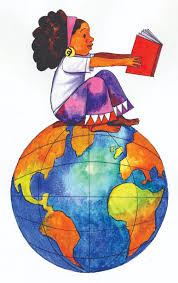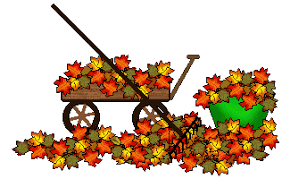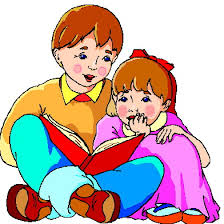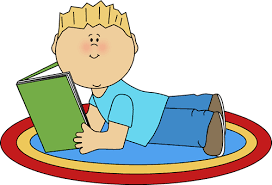 Talking to parents and caregivers about the value of reading aloud with young children is important. Below is a great article found on www.earlymoments.com. We encourage you to visit their website to find literacy building activities and links that support "sharing the gift of reading".
Talking to parents and caregivers about the value of reading aloud with young children is important. Below is a great article found on www.earlymoments.com. We encourage you to visit their website to find literacy building activities and links that support "sharing the gift of reading".
What’s the most important trait you’d like to develop in your child?
If you’re like most parents, intelligence is probably at the top of
your list. We all want bright, smart children, which is why we spend so
much time choosing the right schools and making sure teachers are
exceeding expectations. But remember: as a parent, you have the power
to boost your children's learning potential simply by making books an
integral part of their lives.
We all know reading to our kids is a good thing—but are you familiar
with the specific advantages your toddler or preschool-age child can
receive by being exposed to the merits of reading? Below are some
benefits that highlight the importance of reading to your child between
the ages of two and five.
- A stronger relationship with you. As your child
grows older, he’ll be on the move—playing, running, and constantly
exploring his environment. Snuggling up with a book lets the two of you
slow down and recaptures that sweet, cuddly time you enjoyed when he was
a baby. Instead of being seen as a chore or a task, reading will become
a nurturing activity that will bring the two of you closer together.
 Academic excellence.
One of the primary benefits of reading to toddlers and preschoolers is a
higher aptitude for learning in general. Numerous studies have shown
that students who are exposed to reading before preschool are more
likely to do well in all facets of formal education. After all, if a
student struggles to put together words and sentences, how can he be
expected to grasp the math, science, and social concepts he’ll be
presented with when he begins elementary school?
Academic excellence.
One of the primary benefits of reading to toddlers and preschoolers is a
higher aptitude for learning in general. Numerous studies have shown
that students who are exposed to reading before preschool are more
likely to do well in all facets of formal education. After all, if a
student struggles to put together words and sentences, how can he be
expected to grasp the math, science, and social concepts he’ll be
presented with when he begins elementary school?
- Basic speech skills. Throughout toddlerhood and
preschool, your child is learning critical language and enunciation
skills. By listening to you read One Fish Two Fish Red Fish Blue Fish,
your child is reinforcing the basic sounds that form language. “Pretend
reading”—when a toddler pages through a book with squeals and jabbers
of delight—is a very important pre-literacy activity. As a preschooler,
your child will likely begin sounding out words on his own.
- The basics of how to read a book. Children aren’t
born with an innate knowledge that text is read from left to right, or
that the words on a page are separate from the images. Essential
pre-reading skills like these are among the major benefits of early
reading.
- Better communication skills. When you spend time
reading to toddlers, they’ll be much more likely to express themselves
and relate to others in a healthy way. By witnessing the interactions
between the characters in the books you read, as well as the contact
with you during story time, your child is gaining valuable communication
skills.
- Mastery of language. Early reading for toddlers has been linked to a better grasp of the fundamentals of language as they approach school age.
- More logical thinking skills. Another illustration
of the importance of reading to children is their ability to grasp
abstract concepts, apply logic in various scenarios, recognize cause and
effect, and utilize good judgment. As your toddler or preschooler
begins to relate the scenarios in books to what’s happening in his own
world, he’ll become more excited about the stories you share.
- Acclamation to new experiences. As your child
approaches a major developmental milestone or a potentially stressful
experience, sharing a relevant story is a great way to help ease the
transition. For instance, if your little one is nervous about starting
preschool, reading a story dealing with this topic shows her that her
anxiety is normal.
- Enhanced concentration and discipline. Toddlers may
initially squirm and become distracted during story time, but
eventually they’ll learn to stay put for the duration of the book. Along
with reading comprehension comes a stronger self-discipline, longer
attention span, and better memory retention, all of which will serve
your child well when she enters school.
- The knowledge that reading is fun! Early reading
for toddlers helps them view books as an indulgence, not a chore. Kids
who are exposed to reading are much more likely to choose books over
video games, television, and other forms of entertainment as they grow
older.
Books have the power to benefit toddlers and preschoolers in a myriad
of ways. As a parent, reading to your child is one of the most
important things you can do to prepare him with a foundation for
academic excellence.

Below we have included Seasonal & Holiday book lists as well as links. Family Child Care Educators are encouraged to copy and paste the ideas below into a document and share them with families.

Informing parents, grandparents, and guardians about the value of reading and extending learning and curriculum from your program to the child's home is encouraged. If you enjoyed the article above regarding "Strategies for Promoting Early Literacy" you should share it and send it home with each child as well!!
Infants &Toddlers
Leaf Man, by Lois
Ehlert
The Little Old Lady Who Was Not Afraid of Anything, by Linda D. Williams
The Busy Little Squirrel, by
Nancy Tafuri
Woody, Hazel and Little Pip, by
Elsa Beskow
Mouse's First Fall, by
Lauren Thompson
Apples and Pumpkins, by
Anne F. Rockwell
The Fall of Freddie the Leaf: A Story of Life for All
Ages, by Leo Buscaglia
Bad Apple: A Tale of Friendship, by Edward Hemingway
Leaves, by Melvin A.
Berger
Count Down to Fall, by Fran Hawk
When The Leaf Blew In, by Steve Metzger
Plumply, Dumply Pumpkin, by Mary Serfozo
Let's Look at Fall , by Sarah L. Schuette
Snowballs, by Lois Ehlert
The First Day of Winter, by Denise Fleming
Snow, by Mania Stojic
Frozen Noses, by Jan Carr
Under My Hood I Have a Hat, by Karla Kuskin
Bedtime for Little Bears!, by David Bedford
Tracks in the Snow, by Wong Herbert Yee
Cleo in the Snow, by Caroline Mockford
Mouse's First Snow, by Lauren Thompson
 Preschoolers
Preschoolers
Apples,

by Jacqueline Farmer
Leaf Jumpers, by Carole
Gerber
A Friend for All Seasons, by Julia Hubery
When Autumn Falls, by Kelli Nidley
Lucky Leaf, by Kevin O’Malley
Apple Cider-Making Days, by Ann Purnell
Autumn: An Alphabet Acrostic, by Steven Schnur
Apple Picking Time, by Michele Benoit Slawson
Patty’s Pumpkin Patch, by Teri Sloat
I Know It’s Autumn, by Eileen Spinelli
The Apple Pie That Papa Baked, by Lauren Thompson
Apples, Apples, Apples, by Nancy Elizabeth Wallace
Dot & Jabber and the Great Acorn Mystery, by
Ellen Stoll Walsh
Apple Farmer Annie, by Monica wellington
Owl Moon, by Jane Yolen
The Snowy Day, by Ezra Jack Keats
Stranger in the Woods, by Carl R. Sams II & Jean
Stoick
Katy and the Big Snow, by Virginia Lee Burton
Snow Crazy, by Tracy Gallup
The Snowman, by Raymond Briggs
Frozen Noses, by Jan Carr
Animals in Winter, by Henrietta Bancroft
When Winter Comes, by Nancy Van Lann
Thanksgiving Holiday Book List, activities and you-tube links
Age 0-2
Five Silly Turkeys, Salina Yoon.
Toddlers will love the fun rhyming text of this book
about five turkeys doing silly things.
The story on You Tube
http://youtu.be/UODvu6As4Ug (Extension
activity: Provide turkey prints or templates, a printed version of the story and the question,
“What silly things can you get your turkeys to do?” for each child to take home.
Have parents report back what silly things they did with the turkeys. Encourage them to cut, color, or even glue feathers that you have sent home to their turkey. Have families send their art back to your program for all to see!!!)
Age 3-5

I Know an Old Lady Who Swallowed a Pie by Alison Jackson. A
seasonal version of a classic favorite. (Extension activity: make an old lady
out of a cereal box and have the children retell the story. Have the children
bring in pictures or empty boxes of their favorite foods from home.
Age 5-8
Turkey Trouble by Wendi Silvano. The story of a turkey who
tries on some barnyard disguises so the farmer won’t find him. (Extension
activity: Provide a picture of a turkey and have the kids disguise the turkey.
They can paint the turkey green like an alien, or put ears on the turkey to
make him look like a dog, paste fall leaves to hide the turkey)
 Below we have added some information from the Center for Disease Control, Educators are encouraged to copy and paste "How can I protect my child..." into a document and send it home with families.
Below we have added some information from the Center for Disease Control, Educators are encouraged to copy and paste "How can I protect my child..." into a document and send it home with families. 




 Academic excellence.
One of the primary benefits of reading to toddlers and preschoolers is a
higher aptitude for learning in general. Numerous studies have shown
that students who are exposed to reading before preschool are more
likely to do well in all facets of formal education. After all, if a
student struggles to put together words and sentences, how can he be
expected to grasp the math, science, and social concepts he’ll be
presented with when he begins elementary school?
Academic excellence.
One of the primary benefits of reading to toddlers and preschoolers is a
higher aptitude for learning in general. Numerous studies have shown
that students who are exposed to reading before preschool are more
likely to do well in all facets of formal education. After all, if a
student struggles to put together words and sentences, how can he be
expected to grasp the math, science, and social concepts he’ll be
presented with when he begins elementary school?








